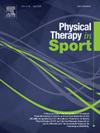The effects of neurocognitive training on pain, proprioception, injury anxiety, and functional and neurocognitive performance in athletes with chronic ankle instability- randomized controlled trial
IF 2.2
3区 医学
Q1 REHABILITATION
引用次数: 0
Abstract
Objectives
Considering the rapid motor-cognitive changes and increased risk of injury in preadolescent athletes, this study investigated the effects of neurocognitive training (NT) on pain, proprioception, injury-related anxiety, and functional and neurocognitive performance in athletes with chronic ankle instability (CAI).
Design
Randomized controlled trial.
Setting
Sports training facilities in Balıkesir, Türkiye.
Participants
Thirty preadolescent athletes with CAI (mean age 11.10 ± 1.06 years) were randomly assigned to an NT group (n = 15) or a control group (n = 13).
Main outcome measures
The Identification of Functional Ankle Instability (IdFAI), Cumberland Ankle Instability Tool (CAIT), pain severity, proprioception (dorsiflexion/plantarflexion), injury-related anxiety, Y Balance Test (YBT), Side Hop Test, Reactive Balance Test (RBT), and Upper Extremity Choice Reaction Time Test were evaluated pre- and post-intervention.
Results
The NT group demonstrated significant improvements in IdFAI (p < 0.001), CAIT (p = 0.004), dorsiflexion (p = 0.003) and plantarflexion proprioception (p = 0.018), injury-related anxiety (p = 0.013), YBT anterior reach (p = 0.048), RBT reaction time (p = 0.030), and accuracy (p = 0.003). The control group showed improvement only in plantarflexion proprioception (p = 0.028), with an increase in post-training pain (p = 0.030).
Conclusions
NT reduced ankle instability symptoms and injury-related anxiety while improving proprioception and neurocognitive performance. NT may enhance functional adaptation by addressing sport-specific cognitive-motor demands.
神经认知训练对慢性踝关节不稳定运动员疼痛、本体感觉、损伤焦虑、功能和神经认知表现的影响——随机对照试验
考虑到青春期前运动员的快速运动认知变化和损伤风险增加,本研究探讨了神经认知训练(NT)对慢性踝关节不稳定(CAI)运动员疼痛、本体感觉、损伤相关焦虑以及功能和神经认知表现的影响。设计随机对照试验。设置体育训练设施Balıkesir, t, rkiye。30名患有CAI的青春期前运动员(平均年龄11.10±1.06岁)被随机分为NT组(n = 15)和对照组(n = 13)。评估干预前后的功能性踝关节不稳定识别(IdFAI)、Cumberland踝关节不稳定工具(CAIT)、疼痛严重程度、本体感觉(背屈/跖屈)、损伤相关焦虑、Y平衡测试(YBT)、侧跳测试、反应性平衡测试(RBT)和上肢选择反应时间测试。结果NT组在IdFAI (p < 0.001)、CAIT (p = 0.004)、背屈(p = 0.003)和跖屈本体感觉(p = 0.018)、损伤相关焦虑(p = 0.013)、YBT前伸(p = 0.048)、RBT反应时间(p = 0.030)和准确性(p = 0.003)方面均有显著改善。对照组仅跖屈本体感觉改善(p = 0.028),训练后疼痛增加(p = 0.030)。结论snt减轻了踝关节不稳症状和损伤相关焦虑,改善了本体感觉和神经认知功能。NT可以通过解决运动特定的认知运动需求来增强功能适应。
本文章由计算机程序翻译,如有差异,请以英文原文为准。
求助全文
约1分钟内获得全文
求助全文
来源期刊

Physical Therapy in Sport
医学-康复医学
CiteScore
4.50
自引率
8.30%
发文量
125
审稿时长
39 days
期刊介绍:
Physical Therapy in Sport is an international peer-reviewed journal that provides a forum for the publication of research and clinical practice material relevant to the healthcare professions involved in sports and exercise medicine, and rehabilitation. The journal publishes material that is indispensable for day-to-day practice and continuing professional development. Physical Therapy in Sport covers topics dealing with the diagnosis, treatment, and prevention of injuries, as well as more general areas of sports and exercise medicine and related sports science.
The journal publishes original research, case studies, reviews, masterclasses, papers on clinical approaches, and book reviews, as well as occasional reports from conferences. Papers are double-blind peer-reviewed by our international advisory board and other international experts, and submissions from a broad range of disciplines are actively encouraged.
 求助内容:
求助内容: 应助结果提醒方式:
应助结果提醒方式:


